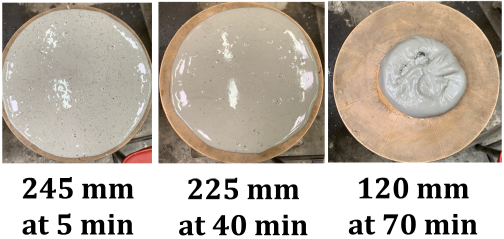Evolution of flow properties, plastic viscosity, and yield stress of alkali-activated fly ash/slag pastes
DOI:
https://doi.org/10.21809/rilemtechlett.2020.123Keywords:
Rheology; Alkali activated materials; Paste fluidity; Viscosity; Yield stressAbstract
The development of cementless concrete is attracting increasing attention in practice and research to reduce both greenhouse gas emissions and energy consumption of concrete. Alkali-activated materials (AAMs) are one of the viable alternatives to replace Portland cement due to their lower CO2 emissions. This study investigated the evolution of rheological parameters of alkali-activated fly ash/slag pastes as a function of time. Flowability and rheological measurements were carried out to determine the fluidity, plastic viscosity, and yield stress at different time intervals. The effects of the slag content, the concentration of SiO2 in the activator, and the solution/binder ratio were considered. Based on the results, the yield stress and plastic viscosity followed an increasing trend over time coinciding with a reduction in the paste fluidity. The plastic viscosity of AAM pastes was in the range of 1.3–9.5 Pa.s and 2.6–28.9 Pa.s after 5 min and 45 min of mixing, respectively. Given the same alkali activator, the higher content of slag the paste had, the higher yield stress the paste showed. In addition, this paper confirmed that the SiO2/Na2O ratio in the activator had no significant effect on yield stress, but a drastic effect of this ratio was found on the plastic viscosity of the paste.

Downloads
Published
How to Cite
Issue
Section
License
Authors retain copyright of the articles published in RILEM Technical Letters and grant the journal the right of first publication with open access. The work is simultaneously licensed under Creative Commons Attribution 4.0 International License (CC BY 4.0) that allows others to share and adapt the work under the following terms: 1) a proper attribution is given in a form of bibliographic record with the DOI link directing to RILEM Technical Letters; 2) a link to the license is provided; 3) the changes (if any) are indicated.









